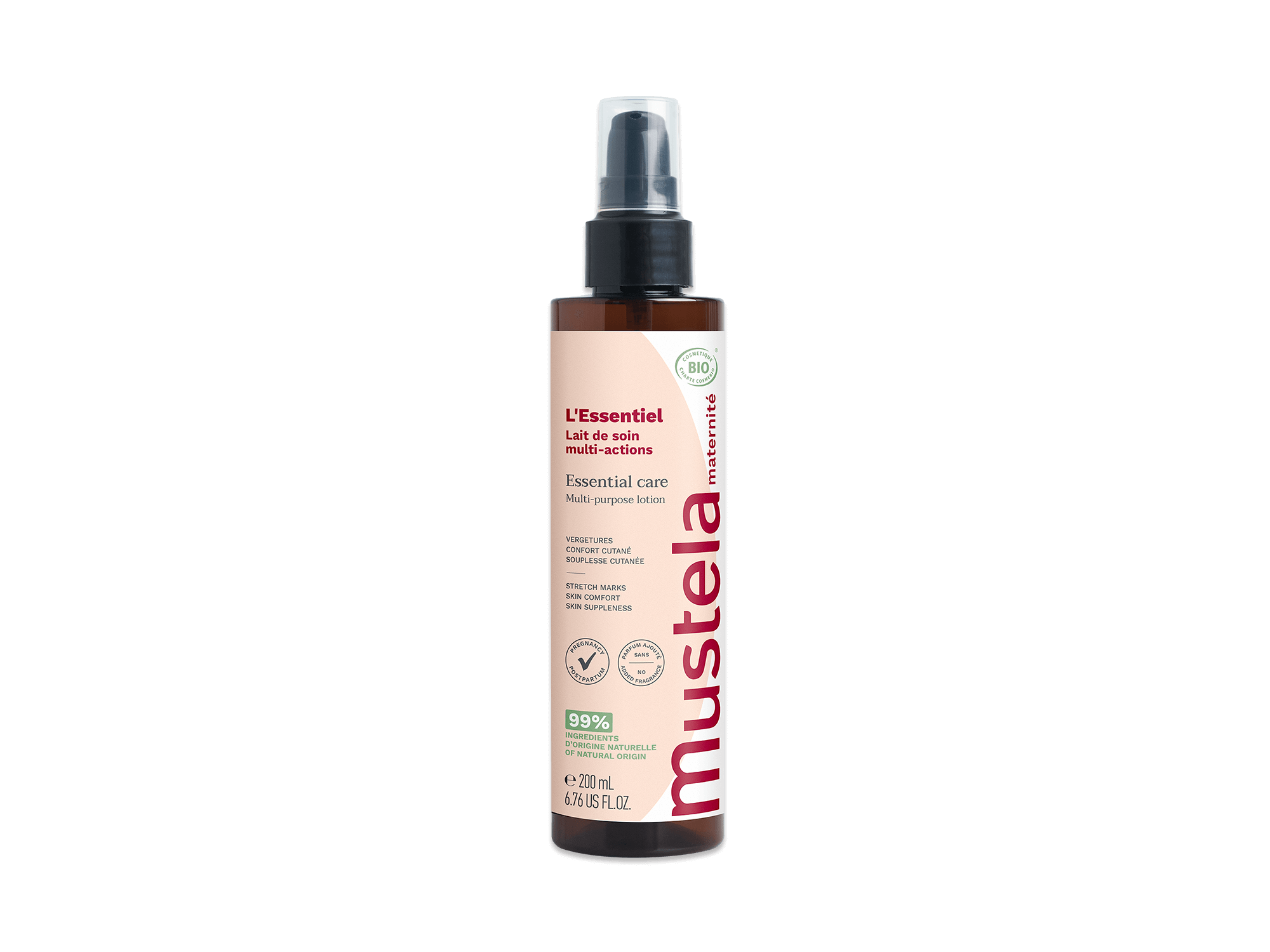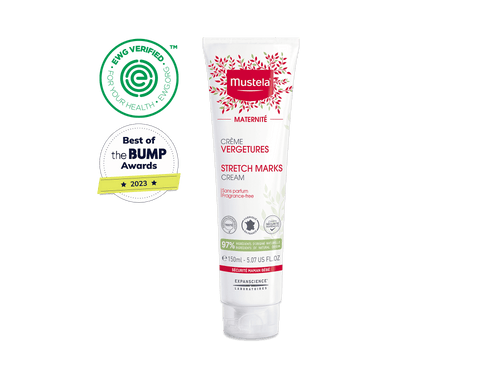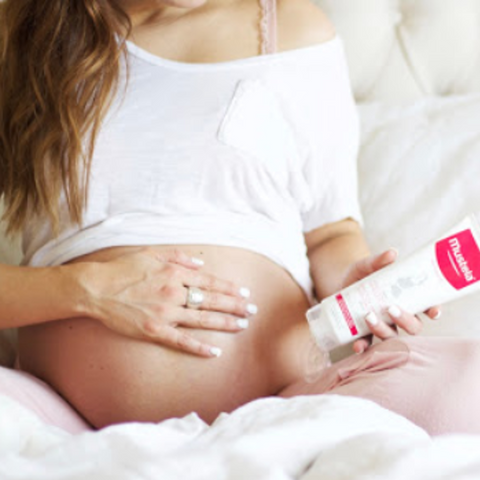When you’re pregnant, your body goes through a lot of changes. The majority of those changes are a wonderful part of motherhood. But some — like stretch marks and itchy, dry skin — can be extremely uncomfortable.
To make matters worse, stretch marks and itchy skin can occur in the exact same spot, at the exact same time. As if one thing wasn’t enough to manage, now you’ve got two! Let Mustela’s experts show you how to minimize itchy stretch marks before they become a major problem.
Along the way, we’ll answer some very important questions, such as:
- What are stretch marks?
- Why do stretch marks become dry?
We’ll also give you five simple steps to help minimize the appearance of even the most stubborn itchy stretch marks. Let’s get started!
What Are Stretch Marks?
Stretch marks are small tears that start in the middle layer of your skin (the dermis) and extend up into the top layer of your skin (the epidermis).
Under normal circumstances, your skin can stretch without tearing, thanks to the naturally occurring collagen and elastin fibers that add an elastic quality to your skin. But when your skin exceeds its ability to stretch or stretches too fast, tearing and scarring occur.
The result is white or sometimes discolored lines on your belly, thighs, and chest. Stretch marks usually form gradually over the span of a month or two, so there’s little pain involved.
When a tear first occurs, your body gets right to work healing the “wound,” but the skin on top of the stretch mark can stay tight and extremely dry long after the tear has healed. It’s this latter issue — dryness — that makes the problem even worse.
Why Do Stretch Marks Become Itchy?
Dry skin is the result of a weakening — or the complete breakdown — of a layer of fat, oil, and water (the hydrolipidic barrier) on the surface of your skin. When the hydrolipidic barrier stops working correctly, small holes can form.
These holes allow vital moisture to evaporate quickly into the air. The lack of moisture in and next to your skin leads to dry, itchy patches.
Unfortunately, dry skin is often caused by an internal imbalance of hormones that prevents the hydrolipidic barrier from functioning at 100%.
That hormonal imbalance is at its worst during pregnancy. The likelihood, then, of developing dry skin while you’re pregnant is very high because of all the hormones that are released during those nine months.
To sum up, itchy stretch marks are actually two separate problems: dry skin and small scars. The first part you want to address is the itchiness because it’s the most disruptive and uncomfortable.

After you have the itchiness under control, then you can start to work on the stretch marks underneath. Or better yet, tackle both at the same time! We’ve got a few suggestions to do so.
But before we get to that, there’s one other thing we’d like to mention. If you’ve read this far and think that the itchy stretch marks you’re experiencing are more than simply dry skin and stretch marks, it could be something called pregnancy rash.
Pregnancy Rash
Pregnancy rash is also known as pruritic urticarial papules and plaques of pregnancy (PUPPP) and polymorphic eruption of pregnancy (PEP). We’ll refer to it as PUPPP.
It’s a relatively common skin condition in pregnant women and is more prevalent in women who are pregnant for the first time, are carrying more than one baby, or are pregnant with a boy (strange, right?). Doctors aren’t entirely sure what causes it.
Typically, PUPPP makes an appearance in the third trimester and goes away a couple of weeks after your baby is born. The good news is that this rash is not harmful to you or your baby, though it can be quite itchy and annoying.
What are the symptoms, and what does it have to do with stretch marks?
The reason you might confuse this rash with regular itchy stretch marks is that PUPPP begins in your stretch marks as tiny, itchy, pink or red bumps. After a few days, it could form larger red skin plaques, spreading from your belly to your legs, bottom, arms, and hands.
It’s also important to know that a red, itchy rash could also be a more concerning skin condition called pemphigoid gestationis (PG).
Regardless, if your itchy stretch marks look like anything more than just dry, itchy skin, it’s best to let your doctor take a look.

If you have PUPPP, your doctor may advise you to apply a topical steroid or corticosteroid cream or take an oral antihistamine to control the symptoms.
There are also natural ways to calm PUPPP and treat the symptoms while you wait for your baby to arrive. Check out our article here.
All of that being said, let’s get back to itchy stretch marks and how to manage them!
How To Manage Itchy Stretch Marks
The best time to deal with itchy stretch marks is early and often. Don’t wait until the stretching and itching have started. Begin adding the following practices into your daily skincare routine as soon as you know you’re pregnant.

1) Apply A Hydrator & A Moisturizer At Least Three Times A Day
One of the things that keeps your skin smooth, supple, and healthy is moisture. When you get right down to it, moisture can help prevent and treat both stretch marks and dry, itchy skin.
Now that you know moisture can be used to lessen the effects of both stretch marks and dry skin, you may be wondering about two of the words we used in the subheading for this section: hydrator and moisturizer.
Aren’t those the same thing? Not exactly. In fact, they actually perform two separate functions.
Hydrators Versus Moisturizers
Once applied, a moisturizer forms a layer on the surface of your skin that locks moisture in and prevents it from evaporating. You might think of moisturizer as a hydrolipidic barrier in a bottle (or tube). A hydrator, on the other hand, is designed to actually put new water into your skin.

To soothe your skin, we recommend a product like Mustela’s Stretch Marks Oil. This fast-absorbing, nourishing oil is specially formulated to deliver hydration.
And since it’s made with 100% ingredients of natural origin per ISO 16128 standard, you can rest assured that our stretch marks oil is safe for both you and your unborn baby! It’s EWG Verified, paraben-free, phthalate-free, and phenoxyethanol-free.
After you’ve applied this oil, top it off with a moisturizer to lock in the moisture. We recommend a natural-based product, like Mustela’s Essential Care Multi-Purpose Lotion to soothe and nourish skin.
2) Massage Your Skin With Oil To Minimize Itchy Stretch Marks

Massaging stretch-marked skin is a great way to break up the scar tissue that makes lines permanent. It can also be an effective way to heal itchy skin when you use an oil product during the massage.
That’s right! Oil-based products can be used as a hydrator as well as a massage oil. Take Mustela’s Stretch Marks Oil, for example. It contains natural ingredients, like beeswax, shea butter, and musk rose.
The combination of these ingredients:
- Improves your skin’s elasticity
- Helps your skin withstand stretching
- Keeps your skin feeling supple and silky-smooth
The oiliness of the product also reduces friction so your skin doesn’t get damaged further.
If you’re not quite sure where to start with a stretch-marks massage, don’t worry. There’s nothing to it! Here’s what you need to know.
Tips For A Great Massage
- Pour a bit of Mustela’s Stretch Marks Oil into the palm of your hand.
- Rub your hands together to spread the oil evenly.
- Gently massage stretch-marked skin by alternating between small circular motions and an easy kneading action.
- Focus on one area for five minutes before moving on to another area.
- Add more oil as needed or if your skin starts to feel too warm.
This soothing massage is great to do at the end of the day while watching TV or before going to sleep. Just leave the oil on when you’re finished so it can continue to soothe and heal.
3) Wash With A Gentle Moisturizing Cleanser
Bathing is a necessary part of a healthy lifestyle, but the way you kept clean before you conceived may not work as well once you’re pregnant. This is because your body’s going through a lot of changes, and your skin’s chemistry is reacting to a surge in hormones.
Before you became pregnant, a steaming-hot shower and a bar of regular soap may have been all you needed. Now that you’re pregnant, however, your skin is much more sensitive and prone to drying. The hot water and the harsh soap only exacerbate this problem.
That’s why we suggest showering with lukewarm water and a gentle moisturizing cleanser. This combination will help protect your skin from becoming excessively tight and dry.
If you don’t have a cleanser that’s gentle on your dry, delicate skin, try Mustela’s Organic Cleansing Gel with Olive Oil and Aloe. This sulfate-free cleansing gel will clean your skin without stripping it of those natural oils that it needs.
In fact, it’s so gentle that it’s made for little ones and adults alike! It’s made with 97.5% ingredients of natural origin per ISO 16128 standard, including organic aloe and organic olive oil, which is sourced from family-owned olive groves in the south of France.
4) Pat Your Skin Dry Instead Of Rubbing

The friction caused by rubbing dry, damaged skin with a towel only makes the problem worse. It doesn’t matter if the towel is made from the softest material on Earth. The heat and friction are still going to cause irritation.
Remember, your dry skin has holes in its hydrolipidic barrier, which means moisture can evaporate off the surface. It also means that external toxins like dirt, dust, pollen, and rough material can make your skin red and itchy.
This is because a weak hydrolipidic layer (which results from the lack of adequate moisture) isn’t able to provide sufficient protection against that rough material.
With that in mind, we recommend patting yourself dry after a shower or bath, instead of rubbing. This removes the water without irritating your skin or further damaging its protective layer.
5) Use Specially Formulated Creams And Serums
The best way to manage itchy stretch marks while you’re pregnant — and after — is to use a specially formulated stretch mark or firming cream, such as our Stretch Marks Cream, Stretch Marks Oil, or Essential Care Multi-Purpose Lotion.
These products contain natural ingredients that improve your skin’s elasticity and help it withstand the stretching that comes with being pregnant.
We also strongly recommend continuing to use these products for a few months postpartum to help increase your skin’s elasticity as your body continues to change.
And because all of Mustela’s products are free of harmful chemicals — like phthalates, parabens, and alcohol — you don’t have to worry about the health of your baby while breastfeeding!
Love The Skin You’re In

Your skin (along with the rest of your body) goes through major changes while you’re growing a baby.
Yes, itchy stretch marks can be frustrating during pregnancy, but if you follow the tips in this article and show your skin some love and TLC, they will be much more manageable!
Apply a hydrator and moisturizer, massage your skin with Stretch Marks Oil, wash with a gentle cleanser, pat dry, and use specially formulated products, like Mustela’s Stretch Marks Cream.
Love the skin you’re in, itchy stretch marks and all. With the right care, you can ditch the itch and minimize the appearance of stretch marks!




















